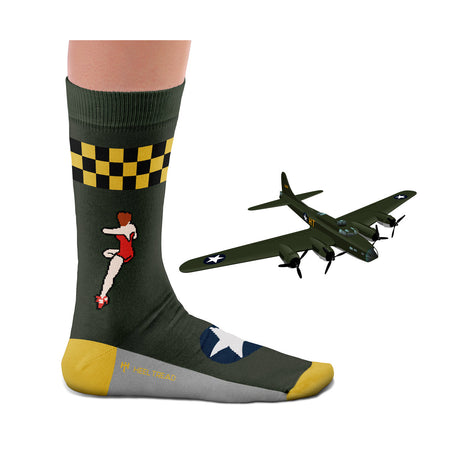



Blackbird Socks
In the late 1950s, the CIA commissioned a top-secret project dubbed 'Archangel', to fly faster and higher than anything before - or since -, invisible as a ghost. The most iconic aircraft of the Cold War was born, the impossibly futuristic spy plane SR-71 Blackbird.
Inspired by aircraft #17962 "Skull and Crossbones".
In May 1960, an American U-2 spy plane was shot down over Soviet airspace. Initially, the U.S. government tried to play down the incident as a stray weather research aircraft but later had to backpedal on that story after photos of the captured pilot and the plane's spy equipment were released. Needless to say, this brought unwanted heat to the Cold War and - along with another U-2 shot down over Cuba - reinforced the need for a new type of spy plane.
The CIA wanted a new plane that could fly at unprecedented altitudes, at impossibly high speeds while remaining invisible to radars. To achieve anything near that, basically, everything had to be invented from scratch. So they called up Clarence "Kelly" Johnson, the best aircraft designer at Lockheed's secret division Skunk Works. The A-12 was the original plane of the Blackbird family in 1962. The final derivative of the A-12, with a twin cockpit and larger fuel tanks, was named SR-71 (for "Strategic Reconnaissance") and painted in a sort of black paint, earning it its nickname.
First flown in December 1964, the SR-71 was an engineering marvel in every sense. Developed to operate stealth aerial reconnaissance missions, the Blackbird was unlike anything that had ever been done before - or has since. It was capable of speeds in excess of Mach 3.3 and an altitude of 85.000 ft (25.900 m) with the help of two specially developed Pratt & Whitney J58 axial turbojets engines. Though they each provided 32.000 lbs of thrust, most of the thrust needed to fly Mach 3 came from the balance produced by air passing through the engine inlet and the conical spike inside the nacelle that adjusted its position to the plane's speed. The blue-yellow-orange flame out the back was 50 feet long, and the stream's shock patterns made it look like it was spitting fireballs.
To put the Blackbird's performance into perspective, the best New York to London time set by the Concorde is 2 hours 52 minutes. The SR-71 did it in 1 hour 54 minutes... but it only took that long because it had to slow down for refuelling.
At full speed, the Blackbird's titanium alloy surface - more on the titanium later - had to be able to withstand temperatures of 600 degrees Fahrenheit (over 300 Celsius). At the time, there weren't any materials to build fuel cells that could operate in such conditions. The cells leaked fuel until reaching high temperatures and expanding, finally sealing the cracks. This meant that the Blackbird, though perfectly capable of lift-off on its own, had to be refuelled almost immediately after being airborne. The array of spy gadgets carried in the Blackbird allowed it to survey 100.000 square miles of Earth's surface per hour (259.000 sq km) with an accuracy that made it possible to identify objects as small as nine inches. Flying at an altitude anti-aircraft fire couldn't reach, faster than a missile, and barely visible to radar meant the SR-71 could usually go about its business undetected - though only 20 of 32 Blackbirds built made it to the end of active duty, none were ever damaged by enemy action. Even the very dark blue paint, seemingly black, was engineered to absorb enemy radar signals. In the rare event of a detection, the window for an enemy surface-to-air missile's radar to acquire and track the aircraft was so small, that when it, and if, it finally launched, the SR-71's pilot could easily avoid it just by stepping on the gas.
Ironically, this wonder of technology had an all-analogue cockpit. To minimize the fuselage's cross-section (and the radar signature) the space was cramped and the two-man crew had to wear special pressure suits in order to deal with the lack of oxygen and extreme temperatures found near the edge of space.
By modern standards, what the designers were able to pull off with the limited technology available is nothing short of a miracle, overcoming obstacles in unchartered aviation engineering and dealing with the complexities of space travel itself.
Spy satellites, drones, and eye-watering operational costs pushed USAF's option to start shutting down the SR-71 fleet in 1990 - NASA flew the last two airworthy Blackbirds until 1999 for aeronautical research. But, after three decades of active duty and over five decades since setting records that have never been beaten, the Blackbird leaves a hole that has yet to be filled.
A flying object that still feels to us more like something from the future than anything we have today.
80% Combed Cotton, 17% Polyamide, 3% Elastane.
We use seamless knitting to create a sock with no stitches.
Wash inside out (40ºC/100ºF max). Do not tumble dry, iron, bleach or dry clean.
80% Combed Cotton, 17% Polyamide, 3% Elastane.
Made in Portugal using the most advanced craftsmanship to produce the finest seamless socks.
Wash inside out (40ºC/100ºF max). Do not tumble dry, iron.
Sock Size
| EU | 36-40 | 41-46 |
| UK | 4-7 | 7½-11½ |
| US M | 4½-7½ | 8-12 |
| US W | 6-9½ | 10-12½ |









